Establish oversight over language access programs through the development of a state or district language access plan, creation of an oversight body, and/or creation of a language access coordinator position.
Action Step 2 details recommendations on how to establish effective oversight, including the creation of an oversight committee, the establishment of a language access coordinator position, the development of a state Language Access Plan (LAP), and or the revision of an existing plan.
Over the past 5 years, jurisdictions have made impressive strides in establishing oversight and maintaining pre-established oversight. The majority of jurisdictions stated in the survey that they currently have an oversight body, a statewide coordinator, and/or a statewide language access plan.
Oversight Bodies and Language Access Coordinators
The existence of an oversight body and a language access coordinator is arguably one of the most important indicators of a jurisdiction’s commitment toward improvement. Establishing an oversight body, such as a language access office and/or a coordinator greatly assists with the coordination of services, facilitating the development, communication, and monitoring of language access policies and procedures.
Almost 80% of jurisdictions report that they currently have an oversight body that provides language access-related policies and programs. (Figure Q5 below.) Also, 81% of jurisdictions stated that they have a statewide language access coordinator position. (Figure Q6 below.) As seen in question 42, jurisdictions overwhelmingly attributed their overall success and improvements to having a full time language access coordinator.
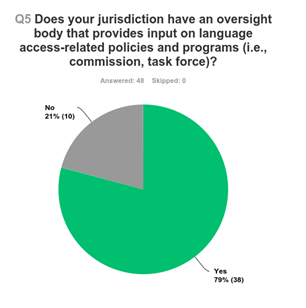
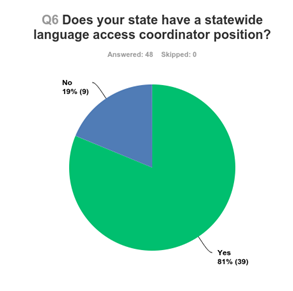
Language Access Plans (LAPs)
At the Summit, there was a great deal of focus on the importance of developing a state Language Access Plan (LAP), and/or the revision of an existing plan. In the years following the Summit, many resources, through funding efforts, have been put toward supporting creating LAPs or updating existing LAPs.
This intensive focus and support for LAPs has yielded extremely successful results. Most jurisdictions, 84% of respondents, report that they currently have a statewide LAP. (Fig. Q7.) In addition, 64% of respondents stated that they have updated or revised an existing LAP in the last five years. (Fig. Q8.)
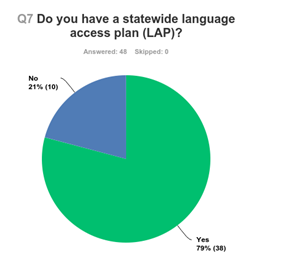
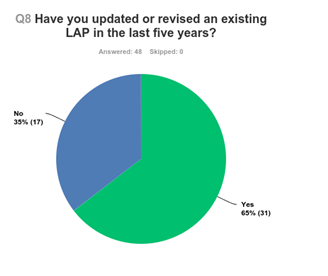
LAP Oversight
Jurisdictions assign the duty of overseeing the implementation of their LAP to a variety of persons or entities. At the Summit, when developing steps to implement their LAPs, jurisdictions were asked to identify the individual or entity that would kick off and implement the LAP. This pre-planning created consensus among the key stakeholders attending the Summit and assisted with the immediate implementation of the plans.
Jurisdictions have a number of options of who is best situated to oversee the LAP. The survey asked respondents to identify who is responsible for LAP oversight.
Q9: Who (person or entity) oversees the implementation of the LAP?
Some jurisdictions reported that both a point person and an entity were charged with overseeing their LAP:
- LAP Implementation Coordinator and the LEP Committee.
- Statewide Language Access Coordinator and Interpreter Advisory Committee.
- Language Access Coordinator, Division Director, Clerk of the Court, Executive Officer, Language Access Committee, Standing Committee on Fairness & Access.
Other jurisdictions reported having either a specific person or entity that oversees their LAP:
|
PERSON |
ENTITY |
|
|
Components of an LAP
A successful LAP should provide both a strategic framework with realistic goals and procedures and policies to improve meaningful access for LEP court users. Jurisdictions reported on the key components their plans include.
Q10 What Components does your LAP include? Check all that apply:
Listed below in the chart are the most frequently included components, including services, training, and notification procedures.
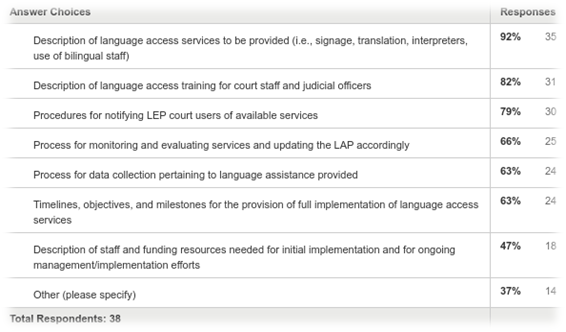
Jurisdictions have gone well beyond the list of components listed above. In the survey, respondents detailed the following additional components in their plans that were not listed as multiple choice options:
- The Language Access Plan's 8 goals: 1. Improve early identification of and data collection on language needs; 2. provide qualified language access services in all judicial proceedings; 3. provide language access services at all points of contact outside of judicial proceedings; 4. provide high quality multilingual translation and signage; 5. Expand high quality language access through the recruitment and training of language access providers; 6. provide judicial branch training on language access policies and procedures; 7. conduct outreach to communities regarding language access services; and 8. identify systems, funding and legislation necessary for plan implementation and language access management.
- The Branch's Policy Statement of Commitment Regarding Limited English Proficiency, the charge to the LEP Committee, the function of the Interpreter and Translator Services Unit, including the description of its centralized scheduling system for statewide language requests, pilot projects.
- Statutes, orders, rules for governing use of interpreters. Code of professional conduct.
- Governing laws, rules and policies.
- Standards for ethics, training and testing of court interpreters.
- The Plan notes that Administrative Rule 6 was revised in 2016 to provide interpreting services by the court for all civil and criminal cases regardless of ability to pay.
- Statement of legal basis for LAP, enumeration of "General Principles of Language Access" for Pennsylvania's courts.
- Certification process; CEU requirements; reporting of expenses for language access; description of language providers and where they can provide services; info about complaint process
- The state court system’s adoption and implementation of successive rule amendments has (1) strengthened interpreting standards in both court and court-related proceedings; and (2) increased the pool of registered and official state-level designated interpreters. The expanded use of shared remote interpreting promotes intra-state interaction and sharing of resources.
- The history of the program in Nevada, certification requirements, what has been done, complaint process, bench card, LAP template and guide for courts to develop separate LAP.
- US Census data Language Access Data & survey results Governance structure Remote interpreting descriptions and data Translation descriptions and data Complaint process.
Most Effective Components of an LAP
Next, the survey asked respondents to identify the most successful aspects of their LAPs, which they would recommend to other jurisdictions.
Q11 What have been the most effective components of your
LAP that you would recommend other jurisdictions adopt and why?
Goals and Standards
- Manageable milestones that fulfill 5 year goals. This makes progress measurable and steady accomplishment of plan objectives.
- The Policy Statement from the Chief Court Administrator reflects the Branch's commitment, the mandatory LEP training to all staff outlining the procedures for accessing language assistance.
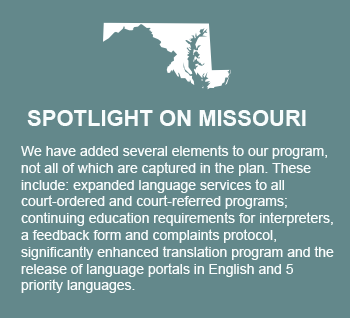 Quality of interpreting services has been strengthened given adoption/implementation of increased interpreting standards in both court and court-related proceedings through successive rule amendments. Expanded use of remote interpreting technology has improved efficiency in case processing through reduction of court delays, improved effectiveness of service delivery by maximizing use of state certified interpreter resources, and increased the opportunity for intra-state resource sharing.
Quality of interpreting services has been strengthened given adoption/implementation of increased interpreting standards in both court and court-related proceedings through successive rule amendments. Expanded use of remote interpreting technology has improved efficiency in case processing through reduction of court delays, improved effectiveness of service delivery by maximizing use of state certified interpreter resources, and increased the opportunity for intra-state resource sharing. - Identifying language needs, and types of language assistance currently provided are one of the most effective components of the LAP in identifying priorities and developing protocols for hiring additional staff interpreters and assigning staff interpreters to at least one Regional Justice Center.
Language Access Coordinators
- Hiring of a full-time Language Services Coordinator to schedule and monitor interpreting services. A case management system that captures the need for interpreting services. The increased use of video remote interpreting to provide qualified interpreters in those regions of the state with adequate bandwidth.
- Statewide LAP has been recently adopted, so its effectiveness is still being evaluated. The local LAPs have been in effect for 2 years, and the appointment of local language access coordinators has been very effective and is recommended.
- Court Interpreting Testing Program, Registry of Interpreting Resources, and the creation of county interpreting units led by a Coordinator of Interpreting Services who also coordinates with the manager of the Language Services Section.
Interpreter Training, Certification and Recruitment
- Holding mandatory onsite orientation sessions for prospective interpreters helps identify those interpreters who are serious about becoming qualified.
- We have been successful with training, outreach and public relations surrounding the importance of language access services, as well as state and federal requirements and how to work effectively with interpreters in court proceedings.
- Training for judges and staff. Ensuring language access at all points of contact: outside the courtroom such as court-ordered services, legal fairs sponsored by the courts, clerk's office, customer service, self-help centers.
- More active approach to the recruitment of certified interpreters increasing the level of access to qualified individuals leading to accurate interpretation in court; educating court staff to increase knowledge of federal and state laws.
- Internship for prospective court interpreters has generated immense interest and enthusiasm, from both college students, their faculty and court staff. It is also a helpful tool for outreach and recruitment.
Centralization
- Centralized scheduling of all language access requests, defining the very specific role of the sworn proceedings interpreter, outlining the state's responsibilities in translating vital documents and defining what 'vital document' actually means.
- We recently transitioned from local, county-level LAP plans to one, statewide LAP plan with centralized oversight and monitoring.
- The establishment/formation of the Language Access Plan Implementation Task Force, comprised of balanced stakeholders in the membership and defining the Task Force's goals and objectives to carry out the implementation of the LAP's 75 recommendations.
Data
- The most effective component of Tennessee’s language access plan that we would recommend other jurisdictions adopt, is the collection of data. Having a system that can help the court system know the languages needed in the court system so that the interpreter program can recruit interpreters in these languages is invaluable.
Miscellaneous
- Standardization of services, best practices documents.
- Block pay-instead of hourly, block pay provides services by an interpreter for as little as one case to ten or more cases for the block period.
- 1) In April 2014, the Hawaii State Judiciary launched enhancements to its website to make it easier for LEP persons and the general public to access important information about language access services. All information about language access services is consolidated under a "Language Access" tab. LEP persons can easily access multilingual content in their language; with just one click from the Judiciary's homepage, LEP persons can get to one of 14 language-specific web pages that compile all documents translated into a specific language in one place. 2) Language ID Cards are business-sized cards that read, "Hello, my name is. I speak ____. Please find someone who can speak my language so we can talk." in English on one side and in language on the other. Developed by the Hawaii State Judiciary under a U.S. Department of Justice grant, Language ID Cards are available in 14 non-English languages frequently encountered in the Hawaii State Courts, including several "rare" Asian and Pacific Island languages. This allows LEP persons to quickly and proactively identify their language need to facilitate provision of language services.
Overall Impact of LAP
The survey then asked respondents if their LAP helped improve the language access services they provide in their jurisdictions. The majority of jurisdictions, over 82%, reported that their LAP improved their language access services. (Fig. Q12.)

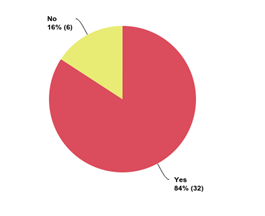
Each jurisdiction then provided an explanation or detail on how their LAPs improved their language access services. One of the most common themes was that the LAP served as a roadmap or guide in implementing policies and standards and establishing clear direction in providing language access services. Also, increased accountability and awareness was essential to making concrete changes and improvements.
Roadmap and Guide
- The Plan serves as a roadmap for making improvements in the delivery of language services. The process of updating the plan gives administrative staff an opportunity to review progress, discuss new challenges, and set new goals.
- The LAP is a roadmap to promote a consistent statewide approach to implement language access services throughout the 58 counties. Also, progress made in the expansion of court interpreter in civil proceedings outlined in the following graphics: (as of December 31, 2016) and (as of September 30, 2015).
- Yes, included in the LAP are Action Steps which serve to guide the Trial Court's progress in providing language access services.
- Yes, the LAP has improved language access as it has guided the Committee on Language Access in putting policies and standards in place to ensure equal access for all.
- The Hawaii State Judicairy recognizes that the LAP is an important component that guides the Judiciary's efforts in working with LEP populations. The LAP ensures that all staff understand the need to identify and address the language of LEP persons in a timely manner to reduce delay, frustration, and costs. Through mandatory staff training, the Judiciary ensures that all staff working across departments know how to identify LEP persons and provide appropriate language access services in a consistent and uniform manner which, in turn, has strengthened the Judiciary's efforts to ensure access to justice for all.
- We identified the areas in which we needed to work to provide equal access to our courts: services provided outside the courtroom and court-ordered services, translation of the judiciary's website and DV and DR forms, training for judges and staff, developed a training and certification program for Navajo and Pueblo languages, which are widely spoken in some specific areas of the state.
- Staff and judges are trained about the services we provide and how to recognize and interact with limited English proficienct individuals. The Plan provides clear direction to judges and staff.
Increased Accountability
- The development and revisions of the written documents has resulted in more accountability within the Branch and increase in awareness of services that need to be provided.
- LAP provides high profile written document that includes accountability measures. We have been able to leverage the LAP to gain grant funding to assist in fulfilling goals: a) stakeholder surveys, b) sustainable language access training for statewide court personnel and judges, c) statewide courthouse language identification tools, d) increased training for interpreters of languages of lesser diffusion, e) improved public counter language access, and f) further implement the use of technology to deliver services.
Increased Awareness and Understanding
- The LAP has raised awareness of language issues, and increased visibility of the Office of Language Access (OLA) and the services and assistance that we can provide; court users are also made aware of the services that are available, through takeaway cards, signage, website, etc.
- Increased awareness and improved understanding of language access policies.
- It has made the staff more aware and better trained to handle requests for language assistance.
- Increased attention to issues like signage, translated materials, website, etc.
- By bringing clarity to language access and its relation to services in the court system.
Miscellaneous
- The creation of local LAPs has allowed me to develop a local point of contact in each circuit court, and has required acknowledgement from each Chief Judge that interpreters be provided for all legal proceedings, civil and criminal, and court-annexed proceedings. Having a point of contact has also allowed me to educate court staff about the importance of using qualified interpreters. The LAPs have also standardized the methods of determining the need for an interpreter and data collection practices.
- Yes, our language access plan has helped improve language access services the Tennessee court system provides. We have discussed the Plan and the need for the plan at statewide trainings and conferences for court system stakeholders. It helps them understand the why and need for a Plan and language access services.
- It has streamlined the assignment of interpreters going into the courtroom and outside attorney appointments, counseling, etc.
- We have been able to develop a robust data collection program to monitor performance and to evaluate the depth of the program.
- The policies and implementation of court interpreter training and testing have resulted in lists of qualified court interpreters by language for use by all Louisiana courts, attorneys, and related parties. The adoption of Louisiana's "Code of Professional Responsibility for Language Interpreters" in the Louisiana Rules of Court has created uniform ethical standards.
- It provides local eyes-on, ears-on to better ensure services are provided and provided as efficiently as possible.
- It is a clear articulation of the Nebraska Supreme Court's outstanding commitment to language access in Nebraska courts and probation services, and it provides a firm foundation upon which to build the program.
- The Plan is descriptive of what is already in place through statute or court rule. It does not add or expand on those rights and responsibilities. It is helpful to the extent that it compiles information from various sources into one document.
- Our Language Access Program is still relatively new. Having a registry of qualified interpreters has assisted both courts and foreign-language-speaking litigants.
Jurisdictions that did not answer affirmatively that their LAPs led to improvements referred to a lack of data to support improvements or that their LAPs were newly implemented.
- Being a centralized office for language access, it is hard to tell if the LAP has had an impact, or if we are successful because everything comes through our office and we are able to control the quality of interpretation as well as maintain the statistics.







